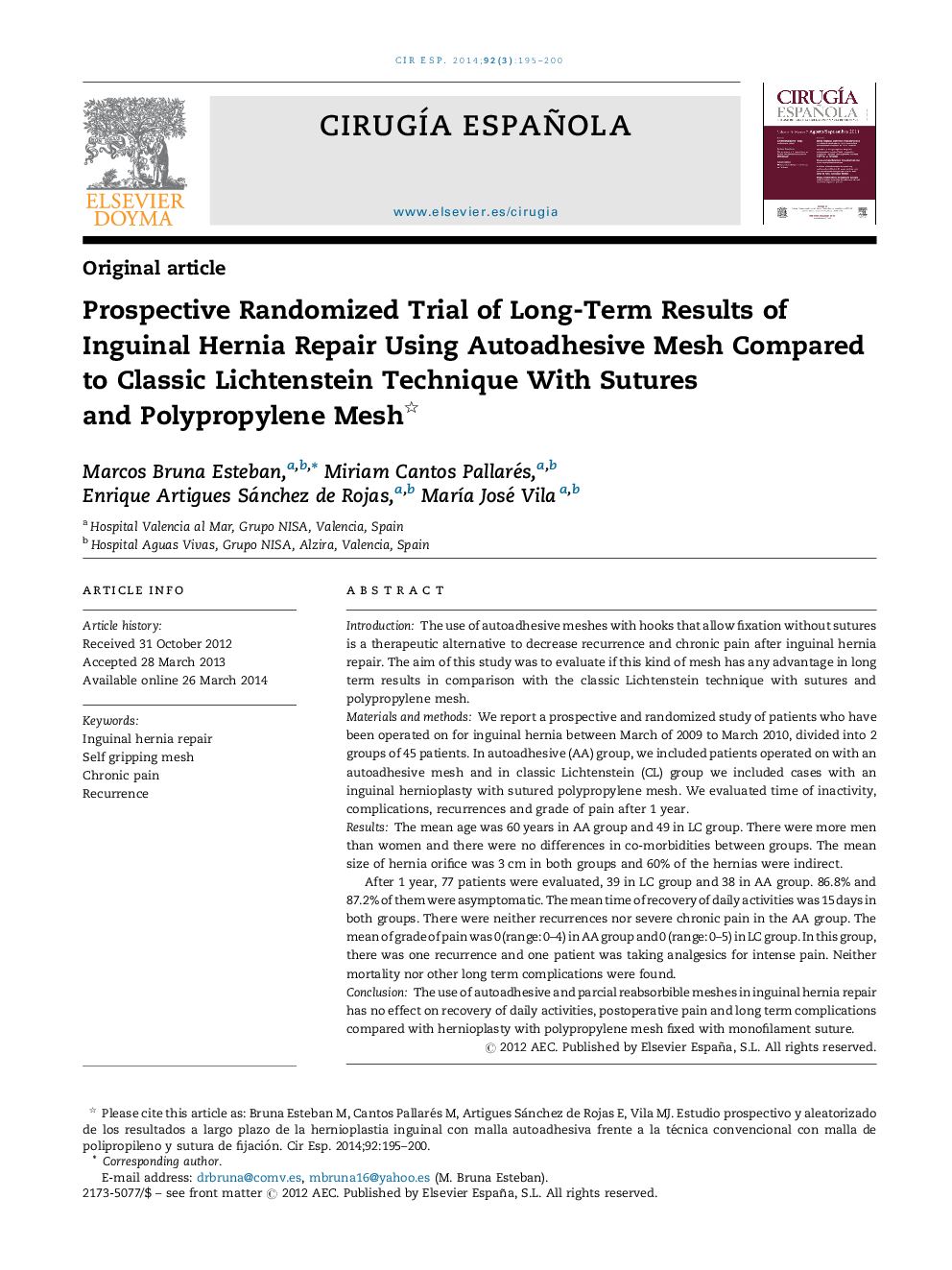| کد مقاله | کد نشریه | سال انتشار | مقاله انگلیسی | نسخه تمام متن |
|---|---|---|---|---|
| 4255116 | 1284424 | 2014 | 6 صفحه PDF | دانلود رایگان |
IntroductionThe use of autoadhesive meshes with hooks that allow fixation without sutures is a therapeutic alternative to decrease recurrence and chronic pain after inguinal hernia repair. The aim of this study was to evaluate if this kind of mesh has any advantage in long term results in comparison with the classic Lichtenstein technique with sutures and polypropylene mesh.Materials and methodsWe report a prospective and randomized study of patients who have been operated on for inguinal hernia between March of 2009 to March 2010, divided into 2 groups of 45 patients. In autoadhesive (AA) group, we included patients operated on with an autoadhesive mesh and in classic Lichtenstein (CL) group we included cases with an inguinal hernioplasty with sutured polypropylene mesh. We evaluated time of inactivity, complications, recurrences and grade of pain after 1 year.ResultsThe mean age was 60 years in AA group and 49 in LC group. There were more men than women and there were no differences in co-morbidities between groups. The mean size of hernia orifice was 3 cm in both groups and 60% of the hernias were indirect.After 1 year, 77 patients were evaluated, 39 in LC group and 38 in AA group. 86.8% and 87.2% of them were asymptomatic. The mean time of recovery of daily activities was 15 days in both groups. There were neither recurrences nor severe chronic pain in the AA group. The mean of grade of pain was 0 (range: 0–4) in AA group and 0 (range: 0–5) in LC group. In this group, there was one recurrence and one patient was taking analgesics for intense pain. Neither mortality nor other long term complications were found.ConclusionThe use of autoadhesive and parcial reabsorbible meshes in inguinal hernia repair has no effect on recovery of daily activities, postoperative pain and long term complications compared with hernioplasty with polypropylene mesh fixed with monofilament suture.
ResumenIntroducciónLas mallas autoadhesivas se plantean como una alternativa para disminuir el dolor crónico y las recidivas en la hernioplastia inguinal. Pretendemos determinar si el empleo de estas mallas representa algún beneficio en el resultado a largo plazo en comparación con la técnica clásica de Lichtenstein fijando la malla con suturas.Material y métodosEstudio prospectivo y aleatorizado de pacientes intervenidos de hernia inguinal entre marzo de 2009 y marzo del 2010, incluyendo en el grupo autoadhesivo (AA) 45 individuos en los que se realizó la hernioplastia con malla autoadhesiva y en el grupo Lichtenstein clásico (LC) otros 45 utilizando una malla de polipropileno fijada con sutura monofilar. Se evaluaron tiempo de inactividad, posibles complicaciones, recidivas y grado de dolor al año de la intervención.ResultadosLa edad media del grupo AA fue de 60 años frente a los 49 del grupo LC. En ambos, la mayor parte eran varones sin diferencias en las comorbilidades asociadas, siendo el tamaño medio del defecto herniario de 3 cm; en torno al 60% de las hernias eran indirectas. Al año de la intervención, 39 pacientes fueron evaluados en el grupo LC y 38 en el AA. La mediana del tiempo de recuperación de la actividad diaria normal fue de 15 días en ambos grupos. En el grupo AA, el 86,8% estaban asintomáticos, ninguno presentó recidiva herniaria ni precisó tomar analgésicos de forma continua, siendo la mediana del grado de dolor de 0. En el grupo LC, el 87,2% permanecían asintomáticos, un paciente (2,6%) presentó una recidiva y un paciente (2,6%) requería la toma continua de analgésicos por dolor intenso, siendo la mediana de dolor de 0. No hubo mortalidad ni otras complicaciones a largo plazo.ConclusiónEl empleo de mallas autoadhesivas y parcialmente reabsorbibles en la reparación de la hernia inguinal no presenta diferencias significativas en recuperación, dolor ni complicaciones postoperatorias a largo plazo frente a la hernioplastia con malla de polipropileno fijada con sutura monofilar.
Journal: Cirugía Española (English Edition) - Volume 92, Issue 3, March 2014, Pages 195–200
